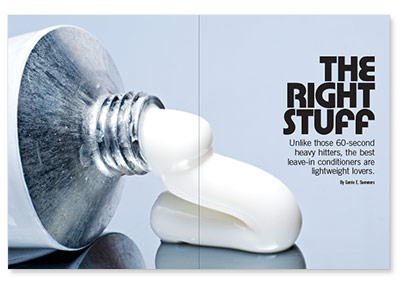
Many black women complain about having dry, breakage-prone hair, and we know that conditioners soften and moisturize tresses. So why not just leave the conditioner in our hair? In fact, some conditioners are designed for that exact purpose. But what makes these leave-in products different from regular conditioners you wash out in the shower? This quick primer will answer your questions.
What’s the difference?
Regular conditioners contain “more thickening agents, emollients and silicones,” explains celebrity hairstylist Monae Everett. A regular conditioner loses some of its softening and hydrating properties once it’s rinsed out, and those ingredients that help achieve “maximum retention on the hair shaft” are easily washed away too. “The leave-in is a lighter, thinner version of the rinse-out conditioner,” Everett says.
These benefits make them especially good for thin or wispy hair. “The heaviness of rinse-out conditioners can weigh down the style,” Everett explains. “This is especially problematic for those with fine hair.”
Isn’t regular conditioner enough?
The quick answer to this question is no. Unlike regular conditioners, leave-ins provide additional moisture and conditioning that last until your next shampoo. A leave-in coats hair strands to seal in moisture and also shield the hair from heat and styling damage. These convenient conditioners also help detangle strands and reduce frizz. What’s more, some leave-in conditioners contain sunscreen to protect against the sun’s ultraviolet rays and environmental damage.
In addition, leave-in conditioners are also good for severely dehydrated hair. As many African-American women know, black hair tends to be dry because its curly strands prevent the scalp’s natural oils from properly coating the hair shaft.
What to look for in a leave-in conditioner
Types of leave-ins: Leave-in conditioners are available in sprays and mists, creams and liquids and oil formulas. Sprays and mists are good for fine, thin hair. (Actually, many people consider detanglers to be a type of leave-in conditioner.) These products typically have ingredients that help loosen tangles and knots in the hair.
Ingredients to look for: “Conditioners should include natural oils, such as olive, coconut, jojoba or rosemary oil. Collagen is also healthy for the hair, and hydrolyzed proteins help to protect the individual strands,” Everett says. Avoid ingredients such as silicone, isopropyl alcohol, petrolatum and mineral oils. “These substances can make your hair dry, clog the pores of your scalp or cause an allergic reaction,” Everett warns.
If you have curly or kinky hair, look for leave-in conditioners with emollients. If you have fine, thin hair, use a leave-in with moisturizing ingredients such as aloe, sodium PCA, hyaluronic acid, protein and panthenol.
How to use a leave-in
Apply leave-ins to damp hair. Dry hair doesn’t absorb the conditioning ingredients, unless you are using a serum. (Serums coat but don’t penetrate the hair shaft.) Just make sure that your hair is not too wet.
Relaxed Hair: “For relaxed hair, leave-in conditioners should be applied to wet hair after regular conditioner is rinsed out, avoiding the scalp,” Everett says. “If [the conditioner is] in a lotion form, apply a quarter-sized amount. If it’s in a spray form, spray throughout the hair. Allow hair to dry with or without heat, then style as desired.”
Natural Hair: To hydrate thirsty curls, use leave-ins the same way that’s recommended for relaxed hair. “When dry hair needs moisture, add water to the leave-in and mist into the hair,” Everett suggests. “A few sprays will go a long way.”






Comments
Comments